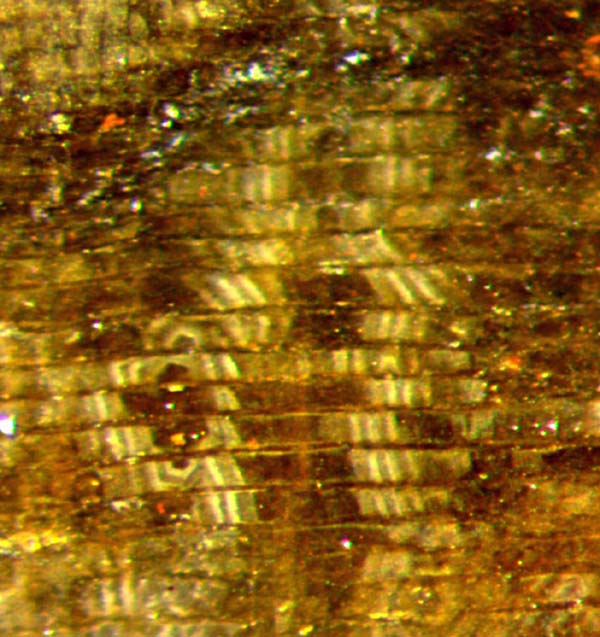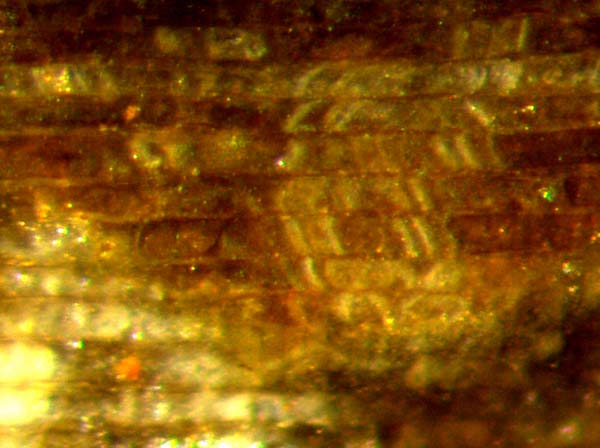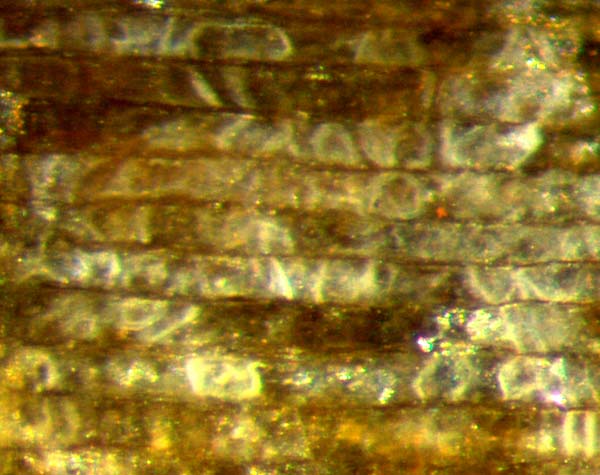Apparition in the wood
 While inspecting lots of samples of dull
dark petrified wood, hoping in vain to see some detail of anatomical
interest, one greets
even an uncanny apparition like the one seen here as a welcome surprise
but only as long as one does not try to explain it.
While inspecting lots of samples of dull
dark petrified wood, hoping in vain to see some detail of anatomical
interest, one greets
even an uncanny apparition like the one seen here as a welcome surprise
but only as long as one does not try to explain it.
Fig.1:
Lateral view on an array of coniferous wood tracheids exposed on an
old fracture face on the surface of a piece of petrified wood, with
enigmatic silicification phenomena affecting several tracheids
simultaneously. Image width 0.7mm.
One of the cracks which had shaped the fragment by breaking
a petrified tree trunk to pieces had felt the wood
structure and was guided
along an array of tracheids such that it looks as if it had been cut
this way on purpose.
The horizontal dark lines separate the wood
tracheids with
diameters of about 50Ám. In the corner above left there are a few cells
of a cut-off pith ray which are not relevant here.
Obviously all the conspicuous bright-coloured
slabs and angular objects seen in the tracheids do
not belong
there. Their periodicity could possibly
be due to changing outer parameters (temperature etc.) or to
intrinsic dynamics of the silicification process.
Judging from some similarity
with the well-known white spots on
silicified wood cross-sections (Fossil
Wood News 2)
it can be tentatively assumed that the
process is triggered by
substances released from live or decaying organisms in the wood,
possibly fungus hyphae or microbes.
The phenomenon shown in Fig.1 involves several correlations of details:
(1)
Affected are not any tracheids but neighbouring ones only, with the
affected sections of the tracheids mutually adjoining.
(2) Every affected section of a
tracheid consists of a dark or transparent
centre and a bright-coloured
region above and below (right and left in
this image). These two regions are obviously correlated: equal number
and tilt of plates in either region inside the tracheid.
(3) Angular objects instead of plates seem to be miraculously
correlated across 5 tracheids.
 The following images are
thought to provide complementary evidence
without providing a way towards an explanation.
The following images are
thought to provide complementary evidence
without providing a way towards an explanation.
Fig.2 (right): similar as Fig.1, tracheids
slightly wider, with silicification products seen mutually
correlated within and without. Image width 0.7mm.

Fig.3 (left): similar as Fig.1,
tracheids wider, upright and tilted plates inside tracheids reduced
in favour of bag-like structures making use of tilted plates and
angular
elements. Image width 0.7mm.
So it appears that the present contribution presents another
enigmatic observation but no explanation.
Sample: collected at Borxleben gravel pit with the permission
by
W.+G. Etzrodt,
1995.
H.-J.
Weiss
2018
|

|
 28 28 |

 28
28 While inspecting lots of samples of dull
dark petrified wood, hoping in vain to see some detail of anatomical
interest, one greets
even an uncanny apparition like the one seen here as a welcome surprise
but only as long as one does not try to explain it.
While inspecting lots of samples of dull
dark petrified wood, hoping in vain to see some detail of anatomical
interest, one greets
even an uncanny apparition like the one seen here as a welcome surprise
but only as long as one does not try to explain it.  The following images are
thought to provide complementary evidence
without providing a way towards an explanation.
The following images are
thought to provide complementary evidence
without providing a way towards an explanation. 

 28
28